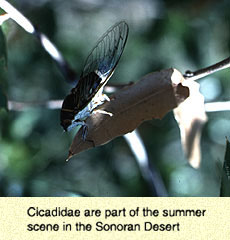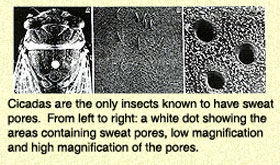from sonorensis, Volume 17, Number 1 (Spring 1997)
 Robert L. Smith
Robert L. SmithDepartment of Entomology
University of Arizona
One distasteful seasonal ritual well known to most human inhabitants of the Sonoran Desert is the annual maintenance required to keep our evaporative coolers operational. You know how this goes: first the draining, followed by the scraping, acid treatment, repeated flushing, belt adjustment, bearing lubrication, and of course, replacement of the fossilized cooling pads. These procedures prepare the clunky contraptions for their noble service: Keeping us somewhere between reasonably comfortable and slightly above comatose (depending on ambient humidity) through the long hot summer. Interestingly there is a population of fascinating insects that exhibit a desert adaptation remarkably analogous to our own mechanical and personal cooling systems.
Sometime between mid- and late-May, a desert adapted cicada emerges and noisily announces "cooler renovation time." The cicada, Cacama dissimilis Distant, is a species commonly known as the "cactus dodger." This name aptly describes the frenetic courtship behavior exhibited by males of the species. As is typical of most cicadas (and a variety of other animals), cactus dodger males sing to attract females with whom they hope to mate. Cicada songs you will probably recall, consist of a cacophony of variously modulated and distinctly patterned rattles or buzzes. These sounds are produced by paired abdominal membranous structures called tymbals. Unlike males of most other cicada species, cactus dodgers do not stay put on a favored perch, singing incessantly during extended periods of the day. These guys usually sing once, twice, or three times-then high-tail it to another perch, where they sing again. The appearance of a lovely female C. disimilis affords an amorous interlude that briefly suspends the male's song and flight routine. The frequent and noisily conspicuous flights of cactus dodger males take place close to the ground. Thus these raucous Casanovas must navigate among, that is dodge, shrubs and of course cactus, en route to a new singing perch (usually in a creasote bush). Cactus dodger males are not always true to their name. Numerous prickly pear and cholla cactus spines protruding from the tattered bodies of near-end-of-season males bear poignant testimony to the rigors of their lifetime quests for females.
Several years ago, Eric Toolson, an old pal from graduate school, became curious about how a few species of desert cicadas, including the cactus dodger, are able to actively sing, fly, court and mate during the heat of the day in the Sonoran summer through the hottest months of June, July and August. Together with Neil Hadley and Michael Quinlan, Eric initiated scientific investigations on this problem and made some very exciting and unexpected discoveries. Dr. Toolson and his associates found that desert cicadas keep cool in precisely the same way we do when our mechanical coolers fail, by the evaporation of "personal water" from body surfaces. Prior to these discoveries, only humans and a few other mammals were known to cool themselves by the evaporation of sweat.
When threatened with overheating, desert cicadas extract water from their blood and transport it through large ducts to the surface of the thorax, where it evaporates. The cooling that results permits a few desert cicada species to be active when temperatures are so high that their enemies such as birds, lizards, small mammals and cicada killer wasps are incapacitated by the heat. No other insects have been shown to have the ducts required for sweating that facilitates evaporative cooling, and in cicadas from non-arid climes, the ducts have been shown to be many fewer or absent altogether.
 So, why aren't "swamp" coolers employed by long suffering New York City residents during their sweltering summer heat, and why don't the famous periodic cicadas of the eastern United States sweat to cool themselves? For the answers to these questions let's recall a few principles of high school physics. Remember that water has a high specific heat, which is to say, it can take up and store large amounts of heat which it gives up very slowly, unless-unless it can change from the liquid to the gaseous state. In order for liquid water to change to a gas, a large amount of energy in the form of heat is required and the heat is removed in the process. This is the principle of evaporative cooling. The next physics factoid to recall is that an atmosphere which contains few water molecules such as is found in Tucson, is much more hospitable to evaporating water than the summer atmosphere of New York City (and hundreds of other hot non-desert cities) which is nearly saturated with gaseous water. So, the rapid evaporation that occurs in Arizona quickly removes a lot of heat leaving homes, people and cicadas feeling cool and refreshed. Not so for New Yorkers who find themselves perennially bathed in their very own, very hot, personal water, which vaporizes at an agonizingly deliberate rate, or not at all.
So, why aren't "swamp" coolers employed by long suffering New York City residents during their sweltering summer heat, and why don't the famous periodic cicadas of the eastern United States sweat to cool themselves? For the answers to these questions let's recall a few principles of high school physics. Remember that water has a high specific heat, which is to say, it can take up and store large amounts of heat which it gives up very slowly, unless-unless it can change from the liquid to the gaseous state. In order for liquid water to change to a gas, a large amount of energy in the form of heat is required and the heat is removed in the process. This is the principle of evaporative cooling. The next physics factoid to recall is that an atmosphere which contains few water molecules such as is found in Tucson, is much more hospitable to evaporating water than the summer atmosphere of New York City (and hundreds of other hot non-desert cities) which is nearly saturated with gaseous water. So, the rapid evaporation that occurs in Arizona quickly removes a lot of heat leaving homes, people and cicadas feeling cool and refreshed. Not so for New Yorkers who find themselves perennially bathed in their very own, very hot, personal water, which vaporizes at an agonizingly deliberate rate, or not at all.
If evaporative cooling works so well in arid environments, why haven't many other Sonoran Desert animals evolved mechanisms to exploit this system? My friend Eric's research revealed that cicadas lose between 20 and 35 percent of their body water every hour while evaporatively cooling themselves. A water loss of this magnitude would represent an intolerable cost for virtually all other desert animals whose primary problem is not heat, but rather the conservation of their precious water. Cicadas can afford the extravagant use of water for cooling because they feed directly on the xylem fluid of plants. This is accomplished by means of a beak-like structure which contains the apparatus used to puncture plants' transport tissues and suck up their sap. Sap is very poor in nutrients, so cicadas and their relatives belonging to the insect order Homoptera (including white flies, aphids, tree hoppers and the like) must process copious amounts of this material to extract enough sustenance required for their survival and reproduction. Thus, unlike other desert animals, cicadas have a reliable supply of water with which to replace what's lost through evaporative cooling. We humans, however, evaporatively cool ourselves by shamelessly slurping up what little water remains in the desert's life-giving streams, rivers and aquifers.
Thanks to Martin Kolner and Eric Toolson, graduate school comrades and cicada biologist par excellence. Cicada photo by Martin Kolner. Scanning electron micrograph by Eric Toolson.










